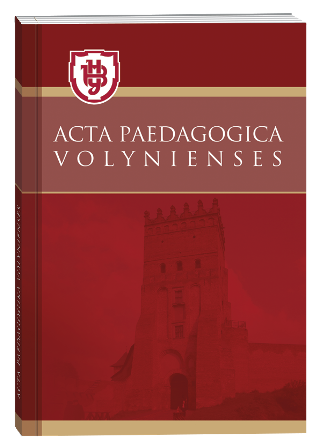WORKING WITH MATHEMATICALLY GIFTED CHILDREN OF SENIOR PRESCHOOL AGE: THEORETICAL ASPECT
DOI:
https://doi.org/10.32782/apv/2022.1.1.9Keywords:
preschool children, gifted children, mathematical competence, logical and mathematical development, Kuizener sticks, Dienes blocks, Nikitin cubesAbstract
The article reveals the concept of “giftedness”. The analysis of psychological-pedagogical and methodical literature
on the specified problem is carried out.
It is revealed that Kuizener’s sticks, Dienes’s blocks, Nikitin’s cubes consist in mastering the development
of mathematical giftedness of older preschool children. The peculiarity of the formation of logical and mathematical competence is the saturation of the educational process with problematic life situations of a practical nature through
play methods and methods of direct learning that activate the cognitive interests of preschool children, develop logical
thinking, train students to use acquired knowledge of mathematics. Mathematics has been found to be a phenomenon
of universal culture, one of the most important areas of knowledge of modern man.
Giftedness – a qualitatively unique combination of abilities, which determines the range of intellectual capabilities
of the child, the uniqueness of its activities and develops throughout its life. Characteristic features of mathematically
gifted children are high cognitive activity and developed intelligence, rich imagination, creativity, ingenuity, clear
motor coordination, physical stability. One of the most important conditions for the development of children’s talents is
the formation of cognitive interest, under the influence of which there are such important components of learning as active
search, guesswork, research approach, readiness to solve problems.
Working with gifted children requires a proper content of classes, focus on the novelty of information, various types
of search, analytical, developmental, creative activities. Teaching preschoolers to think becomes one of the important
pedagogical tasks that need to be solved in the context of personal development of the child in general and logical
and mathematical in particular.
Children’s creativity, novelty and originality of their activities are manifested when they pose a problem on their own
and find ways to solve it. At the same time, their level of creativity is constantly growing, trying to find the optimal ratio
of all activities to get the best results.
References
Босякова С.Н. Работаем с талантливыми детьми. Управление дошкольным образовательным учреждением. 2010. № 2. С. 68–74.
Іщенко Л.В., Журавко Т.В. Психолого-педагогічні особливості формування логіко-математичних компетенцій старших дошкільників. Науковий часопис національного педагогічного університету імені М.П. Драгоманова. Серія 5. Педагогічні науки: реалії та перспективи. Випуск 71 : збірник наукових праць / М-во освіти і науки України, Нац. пед. ун-т імені М. П. Драгоманова. Київ : Видавничий дім «Гельветика», 2019. С. 114–118.
Лазарович Н.Б. Обдарованість у дошкільному віці : навчально-методичний посібник. Берегово : 2009. С. 145.
Мотилько Т.Л. Психолого-педагогічний супровід обдарованих дітей. Київ : Редакції загально-педагогічних газет, 2014. С. 80.
Нікітченко С.І. Вивчаємо математику з паличками Кюїзенера. Дошкільне виховання. 2012. № 3. С. 16–19.
Одаренные дети: Пер. с англ. / Общ. ред. Г.В. Бурменской и В.М. Слуцкого; Предисл. В.М. Слуцкого. Москва : Прогресс, 1991. С. 76.
Розіна О.Ю. Формування логіко-математичної компетентності дошкільників. Кривий Ріг, 2019. С. 7–10.
Савенков А.И. Одаренные дети в детском саду и школе: Учебное пособие для студентов высших педагогических учебных заведений. Москва : Изд-во «Академия», 2000. С. 78.
Татаринова С.О. Проблема формування логіко-математичних понять у дітей старшого дошкільного віку. Зб. наук. праць (Психолог. науки). № 4. Бердянськ : БДПУ, 2007. С. 79–85.







